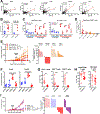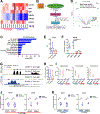Tumor Cell-Intrinsic Factors Underlie Heterogeneity of Immune Cell Infiltration and Response to Immunotherapy
- PMID: 29958801
- PMCID: PMC6707727
- DOI: 10.1016/j.immuni.2018.06.006
Tumor Cell-Intrinsic Factors Underlie Heterogeneity of Immune Cell Infiltration and Response to Immunotherapy
Abstract
The biological and functional heterogeneity between tumors-both across and within cancer types-poses a challenge for immunotherapy. To understand the factors underlying tumor immune heterogeneity and immunotherapy sensitivity, we established a library of congenic tumor cell clones from an autochthonous mouse model of pancreatic adenocarcinoma. These clones generated tumors that recapitulated T cell-inflamed and non-T-cell-inflamed tumor microenvironments upon implantation in immunocompetent mice, with distinct patterns of infiltration by immune cell subsets. Co-injecting tumor cell clones revealed the non-T-cell-inflamed phenotype is dominant and that both quantitative and qualitative features of intratumoral CD8+ T cells determine response to therapy. Transcriptomic and epigenetic analyses revealed tumor-cell-intrinsic production of the chemokine CXCL1 as a determinant of the non-T-cell-inflamed microenvironment, and ablation of CXCL1 promoted T cell infiltration and sensitivity to a combination immunotherapy regimen. Thus, tumor cell-intrinsic factors shape the tumor immune microenvironment and influence the outcome of immunotherapy.
Copyright © 2018. Published by Elsevier Inc.
Conflict of interest statement
Declaration of Interests
The authors have no competing interests.
Figures







Comment in
-
Tumour decides immune cell ins and outs.Nat Rev Immunol. 2018 Aug;18(8):481. doi: 10.1038/s41577-018-0038-y. Nat Rev Immunol. 2018. PMID: 29985485 No abstract available.
-
A Tumor Cell-Intrinsic Yin-Yang Determining Immune Evasion.Immunity. 2018 Jul 17;49(1):11-13. doi: 10.1016/j.immuni.2018.07.001. Immunity. 2018. PMID: 30021140 Free PMC article.
Similar articles
-
Quantitative, qualitative and spatial analysis of lymphocyte infiltration in periampullary and pancreatic adenocarcinoma.Int J Cancer. 2020 Jun 15;146(12):3461-3473. doi: 10.1002/ijc.32945. Epub 2020 Mar 20. Int J Cancer. 2020. PMID: 32129882
-
Intraepithelial Attack Rather than Intratumorally Infiltration of CD8+T Lymphocytes is a Favorable Prognostic Indicator in Pancreatic Ductal Adenocarcinoma.Curr Mol Med. 2017;17(10):689-698. doi: 10.2174/1566524018666180308115705. Curr Mol Med. 2017. PMID: 29521231 Free PMC article.
-
CD25 and TGF-β blockade based on predictive integrated immune ratio inhibits tumor growth in pancreatic cancer.J Transl Med. 2018 Oct 25;16(1):294. doi: 10.1186/s12967-018-1673-6. J Transl Med. 2018. PMID: 30359281 Free PMC article.
-
Dendritic Cells, the T-cell-inflamed Tumor Microenvironment, and Immunotherapy Treatment Response.Clin Cancer Res. 2020 Aug 1;26(15):3901-3907. doi: 10.1158/1078-0432.CCR-19-1321. Epub 2020 Apr 24. Clin Cancer Res. 2020. PMID: 32332013 Free PMC article. Review.
-
T-cell programming in pancreatic adenocarcinoma: a review.Cancer Gene Ther. 2017 Mar;24(3):106-113. doi: 10.1038/cgt.2016.66. Epub 2016 Dec 2. Cancer Gene Ther. 2017. PMID: 27910859 Review.
Cited by
-
CXCL1 promotes colon cancer progression through activation of NF-κB/P300 signaling pathway.Biol Direct. 2022 Nov 25;17(1):34. doi: 10.1186/s13062-022-00348-4. Biol Direct. 2022. PMID: 36434686 Free PMC article.
-
A novel genomic instability-derived lncRNA signature to predict prognosis and immune characteristics of pancreatic ductal adenocarcinoma.Front Immunol. 2022 Sep 15;13:970588. doi: 10.3389/fimmu.2022.970588. eCollection 2022. Front Immunol. 2022. PMID: 36148233 Free PMC article.
-
XGBoost Classifier Based on Computed Tomography Radiomics for Prediction of Tumor-Infiltrating CD8+ T-Cells in Patients With Pancreatic Ductal Adenocarcinoma.Front Oncol. 2021 May 19;11:671333. doi: 10.3389/fonc.2021.671333. eCollection 2021. Front Oncol. 2021. PMID: 34094971 Free PMC article.
-
Divergent outcomes of anti-PD-L1 treatment coupled with host-intrinsic differences in TCR repertoire and distinct T cell activation states in responding versus non-responding tumors.Front Immunol. 2022 Oct 18;13:992630. doi: 10.3389/fimmu.2022.992630. eCollection 2022. Front Immunol. 2022. PMID: 36330507 Free PMC article.
-
Murine Macrophages Modulate Their Inflammatory Profile in Response to Gas Plasma-Inactivated Pancreatic Cancer Cells.Cancers (Basel). 2021 May 21;13(11):2525. doi: 10.3390/cancers13112525. Cancers (Basel). 2021. PMID: 34064000 Free PMC article.
References
-
- Balli D, Rech AJ, Stanger BZ, and Vonderheide RH (2017). Immune Cytolytic Activity Stratifies Molecular Subsets of Human Pancreatic Cancer. Clin. Cancer Res. 23, 3129–3138. - PubMed
Publication types
MeSH terms
Substances
Grants and funding
LinkOut - more resources
Full Text Sources
Other Literature Sources
Medical
Molecular Biology Databases
Research Materials

